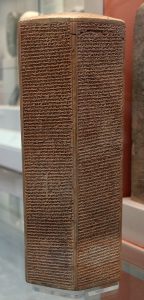Fontes neoassírias? Os textos estão disponíveis no Projeto RINAP, da Universidade da Pensilvânia.
The Royal Inscriptions of the Neo-Assyrian Period (RINAP)
Numerous royally commissioned texts were composed between 744 BC and 609 BC, a period during which Assyria became the dominant power in southwestern Asia. Eight hundred and fifty to nine hundred such inscriptions are known today. The Royal Inscriptions of the Neo-Assyrian Period (RINAP) Project, under the direction of Professor Grant Frame of the University of Pennsylvania, will publish in print and online all of the known royal inscriptions that were composed during the reigns of the Assyrian kings Tiglath-pileser III (744–727 BC), Shalmaneser V (726–722 BC), Sargon II (721–705 BC), Sennacherib (704–681 BC), Esarhaddon (680–669 BC),  Ashurbanipal (668–ca. 631 BC), Aššur-etel-ilāni (ca. 631–627/626 BC), Sîn-šumu-līšir (627/626 BC), Sîn-šarra-iškun (627/626–612 BC), and Aššur-uballiṭ II (611–609 BC), rulers whose deeds were also recorded in the Bible and in some classical sources. The individual texts range from short one-line labels to lengthy, detailed inscriptions with over 1200 lines (4000 words) of text.
Ashurbanipal (668–ca. 631 BC), Aššur-etel-ilāni (ca. 631–627/626 BC), Sîn-šumu-līšir (627/626 BC), Sîn-šarra-iškun (627/626–612 BC), and Aššur-uballiṭ II (611–609 BC), rulers whose deeds were also recorded in the Bible and in some classical sources. The individual texts range from short one-line labels to lengthy, detailed inscriptions with over 1200 lines (4000 words) of text.
These Neo-Assyrian royal inscriptions (744–609 BC) represent only a small, but important part of the vast Neo-Assyrian text corpus. They are written in the Standard Babylonian dialect of Akkadian and provide valuable insight into royal exploits, both on the battlefield and at home, royal ideology, and Assyrian religion. Most of our understanding of the political history of Assyria, and to some extent of Babylonia, comes from these sources. Because this large corpus of texts has not previously been published in one place, the RINAP Project will provide up-to-date editions (with English translations) of Assyrian royal inscriptions from the reign of Tiglath-pileser III (744–727 BC) to the reign of Aššur-uballiṭ II (611–609 BC) in seven print volumes and online, in a fully lemmatized and indexed format. The aim of the project is to make this vast text corpus easily accessible to scholars, students, and the general public. RINAP Online will allow those interested in Assyrian culture, history, language, religion, and texts to efficiently search Akkadian and Sumerian words appearing in the inscriptions and English words used in the translations. Project data will be fully integrated into the Cuneiform Digital Library Initiative (CDLI) and the Open Richly Annotated Cuneiform Corpus (Oracc).
Sobre os Anais de Senaquerib, confira:
A. Kirk Grayson & Jamie Novotny, ‘Survey of the Inscribed Objects Included in Part 1‘, RINAP 3: Sennacherib, The RINAP 3 sub-project of the RINAP Project, 2019.
Um exemplo de como ler as inscrições:
Precisa conferir os Anais de Senaquerib sobre a invasão de Judá em 701 a.C. durante o reinado de Ezequias?
O texto cuneiforme original transliterado e em tradução para o inglês está aqui. Uma opção é: clique em Sennacherib [261] > Sennacherib 022 – Chicago/Taylor Prism, leia a partir de (iii 18).
Lembrando, porém, que há outros textos, no mesmo endereço, que tratam da invasão de Judá em 701 a.C., como o Jerusalem Prism e o Rassam Cylinder.